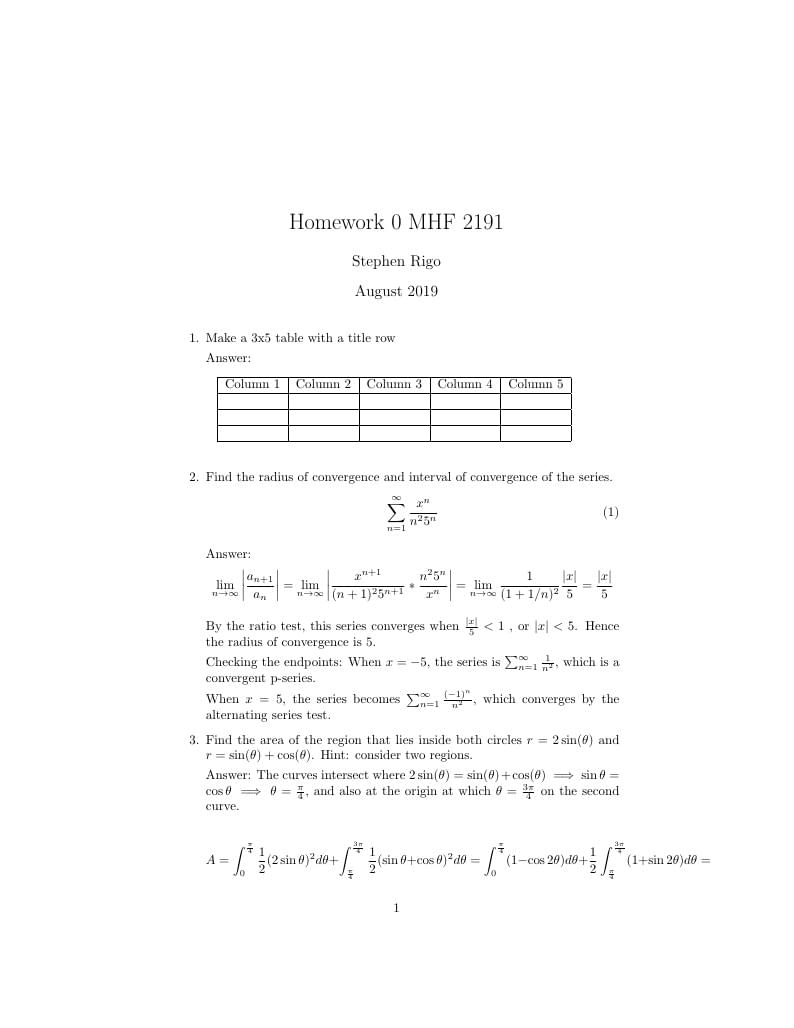
Homework 0 MHF 2191
Author:
Stephen Rigo
Last Updated:
6 anni fa
License:
Creative Commons CC BY 4.0
Abstract:
Homework 0

\begin
Discover why over 20 million people worldwide trust Overleaf with their work.
Homework 0

\begin
Discover why over 20 million people worldwide trust Overleaf with their work.
\documentclass{article}
\usepackage{amsmath}
\usepackage{amssymb}
\usepackage{graphicx}
\title{Homework 0 MHF 2191}
\author{Stephen Rigo }
\date{August 2019}
\begin{document}
\maketitle
\begin{enumerate}
\item
Make a 3x5 table with a title row
Answer:
\begin{table}[htbp]
\centering
\begin{tabular}{|c|c|c|c|c|}
\hline
Column 1 & Column 2 & Column 3 & Column 4 & Column 5\\
\hline
& & & & \\
\hline
& & & & \\
\hline
& & & & \\
\hline
\end{tabular}
\label{tab:my_label}
\end{table}
\item
Find the radius of convergence and interval of convergence of the series.
\begin{equation}
\sum_{n=1}^{\infty} \frac{x^n}{n^25^n}
\end{equation}
Answer:
$$ \lim_{n\to\infty} \left|\frac{a_{n+1}}{a_{n}}\right| = \lim_{n\to\infty}\left|\frac{x^{n+1}}{(n+1)^25^{n+1}}*\frac{n^25^n}{x^n}\right| = \lim_{n\to\infty} \frac{1}{(1+1/n)^2}\frac{|x|}{5} = \frac{|x|}{5} $$
By the ratio test, this series converges when $ \frac{|x|}{5}<1 $ , or $|x|<5$. Hence the radius of convergence is 5.
Checking the endpoints: When $x=-5$, the series is $\sum_{n=1}^{\infty} \frac{1}{n^2}$, which is a convergent p-series.
When $x=5$, the series becomes $\sum_{n=1}^{\infty} \frac{(-1)^n}{n^2}$, which converges by the alternating series test.
\item
Find the area of the region that lies inside both circles $r=2\sin(\theta)$ and $r=\sin(\theta)+\cos(\theta)$. Hint: consider two regions.
Answer:
The curves intersect where $2\sin(\theta)=\sin(\theta)+\cos(\theta)\implies \sin\theta=\cos\theta\implies\theta=\frac{\pi}{4}$, and also at the origin at which $\theta=\frac{3\pi}{4}$ on the second curve.
$$A=\int_{0}^{\frac{\pi}{4}}\frac{1}{2}(2\sin\theta)^2 d\theta+\int_{\frac{\pi}{4}}^{\frac{3\pi}{4}}\frac{1}{2}(\sin\theta+\cos\theta)^2 d\theta = \int_{0}^{\frac{\pi}{4}}(1-\cos2\theta) d\theta+\frac{1}{2}\int_{\frac{\pi}{4}}^{\frac{3\pi}{4}}(1+\sin2\theta) d\theta = $$
$$ [\theta-\frac{1}{2}\sin2\theta]^{\frac{\pi}{4}}_0+[\frac{1}{2}\theta-\frac{1}{4}\cos2\theta]^{\frac{3\pi}{4}}_{\frac{\pi}{4}} = \frac{1}{2}(\pi-1)$$
\item
Create a 4 x 9 matrix. Use bmatrix
Answer:
$$\begin{bmatrix}
1 & 0 & 0 & 0 & 1 & 0 & 0 & 0 & 1 \\
0 & 1 & 0 & 0 & 0 & 1 & 1 & 1 & 0 \\
0 & 0 & 1 & 0 & 0 & 0 & 0 & 1 & 1 \\
0 & 0 & 0 & 1 & 1 & 0 & 0 & 0 & 1 \\
\end{bmatrix}$$
\item
Create an itemized list with an itemized sublist.
\begin{enumerate}
\item (Submitted by Dewey) $x=3$
\item (Submitted by Cheatem) $x=\frac{3}{4}$ or $x=\frac{3}{4}$
\item (Submitted by Andy Howe)
\begin{enumerate}
\item a regular, inline fraction: $x=\frac{3}{\frac{a}{0}}$
\item A fraction centered on a new line with larger size:
\large$$x=\frac{3}{\frac{a}{0}}$$
\item A fraction, inline, but with larger size: \large$x=\frac{3}{\frac{a}{0}}$
\end{enumerate}
\end{enumerate}
\item I can type \textbf{bold text}, \textit{italicized text}, the reals $\mathbb{R}$ using "backslash mathbb" or $\mathbb{R}$ using "backslash R" (since it is a "newcommand") and the integers $\mathbb{Z}$ or $\mathbb{Z}$.
I can even type $x\in\mathbb{N}$ or $A\cap B\subseteq C$.
\item Take a picture of yourself and insert it here. Be sure to upload your picture file with your tex file.
Answer:
\includegraphics[scale=0.5]{MathFoundSelfie.jpg}
\end{enumerate}
\end{document}